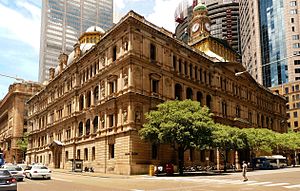- Department of Lands building
-
The Department of Lands building is late nineteenth century building in Bridge Street, Sydney, designed by James Barnet. It is a large three storey public building which was built in different stages. This is the largest building designed by Barnet in Colonial Sydney. The building is listed on the Register of the National Estate,[1] as well as having a NSW state listing. In addition to Barnet, Walter Liberty Vernon and William Edmund Kemp worked on the design of the building. The builder was John Young, who designed St Mary's Cathedral.[2]
Contents
Significance of its location
The positioning of this building on Bridge Street is vital. At that time when this was built, Bridge Street and surrounding areas would not have been filled with present day tall structures. Therefore the visibility of this building and its clock tower from the harbour would uplift this building’s status as an administration office.
Composition and style
Barnet, who favoured Classical styles in his public building projects, designed the Lands Department in Renaissance Revival Style. It was built from 1877-90. Dressed Pyrmont sandstone is the dominant material of the facades, with a dome and tower tops made from copper. The four facades of the building are all richly decorated with classical motifs and statuettes and are dissimilar to each other. Barnet’s mix of the orders and their integration into the building is significant. For example, lowest level of the building is adorned with Doric and Ionic pilasters, whereas Corinthian and Ionic ones are used above. The clock tower has an “onion-dome” which, according to Haskell, was influenced by Sir Henry Parkes’s water carafe.[3]
Main entrance on Bridge Street in relation to other entrances
The main entrance for this building is on Bridge Street. The basement on the Gresham Street side has two entrances as well, one of which was previously used for carriages. Compared to the huge scale of the structure, the main entrance on Bridge Street seems relatively restrained. One might expect a grand entrance in a building of such significance, but Barnet seems to have scaled it down. For an adult standing next to the door, its decorated top is at a comfortable height above the head. This fact makes the Lands Department building seem more practical and public-oriented rather than colossal.
References
- ^ Heritage of Australia, Macmillan Publishers, 1981, p.2/94
- ^ State Heritage Website
- ^ John Haskell, Sydney Architecture (Sydney: University of New South Wales Press, 1997), p.30
Categories:- Buildings and structures in Sydney
- Bridge Street, Sydney
Wikimedia Foundation. 2010.





